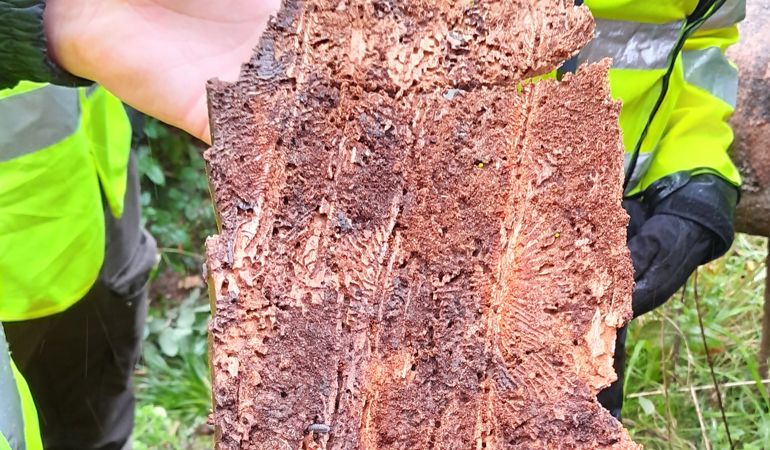NRW’s quick response to beetle threat proves successful but we must remain vigilant

Natural Resources Wales’ Forest Regulations and Tree Health Team have taken action following the discovery of Ips typographus, commonly known as the Eight-toothed spruce bark beetle, in an insect monitoring trap in South East Wales.
Three specimens were found this year in a single trap, which were set up three years ago by Forest Research as part of the Wales Plant Health Surveillance Network (Network (WPHSN).
Following verification by Forest Research Entomologists, the NRW Tree Health Team assisted by NRW Land Management, Forest Operations, Integrated Workforce colleagues and Forest Research specialists undertook a rapid survey of all spruce within 1km of the discovery.
All spruce on NRW and privately-owned land had to be located and a data collection project was created to aid the survey.
All windthrow and windsnap (trees damaged or uprooted by high winds) were surveyed, all spruce was inspected and standing trees with poor crowns were investigated and felled if necessary to prevent them being used as breeding galleries by the beetles.
Bark beetles create tiny intricate tunnels known as galleries under the bark of trees to lay their eggs and raise their larvae in, before the larvae turn in to the adult beetles and are able to take flight and continue their life cycle.
All logs and arisings (cut wood) were either bark stripped, chipped or were tarped to ensure there wasn’t any suitable material for colonisation.
Thankfully no galleries of Ips typographus were found, and subsequent enhanced trapping and surveying throughout the season has not picked up any further Ips typographus interceptions.
There will be further inspections over the winter to locate all windthrow and windsnap and further trapping will take place next year.
As well as this finding in Wales, new Ips typographus findings have been confirmed in the South East of England including the first finding in Great Britain on Sitka spruce.
The finding was on a small number of unhealthy Sitka trees among a stand of infested Norway spruce, also in very poor condition, on a site in West Sussex.
NRW Tree Health, Land Management and Forest Operations staff were recently invited to this site for knowledge transfer, training and networking opportunities with our English, Northern Irish and Scottish colleagues.
Seeing the beetle, its breeding galleries and infested trees in real life has increased our knowledge and confidence of our ability to identify the beetle in the field, and building a close working relationship with the Forestry Commission will help us tackle any future sightings.
Ips typographus is present in south-east England, with the demarcated area reaching as far west as Newbury, Berkshire. Research and modelling indicate that the south-east of Wales would be of higher risk of a finding than other areas of Wales, due to proximity of English sites, climate and availability of spruce.
NRW is calling on all Forest Managers to be vigilant and information about poor spruce or any windthrown spruce on private sites would be very useful. Please contact treehealth@naturalresourceswales.gov.uk with any information.
For more information visit: https://www.gov.wales/ips-typographus
